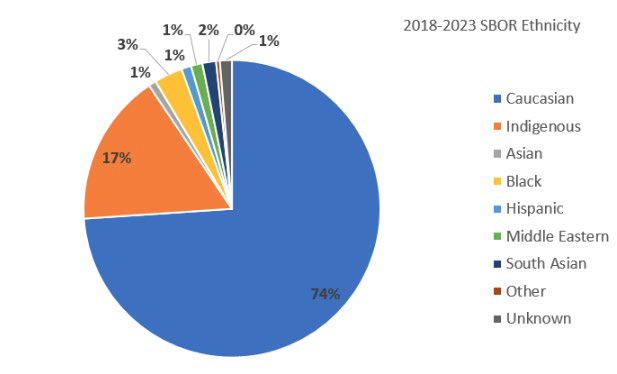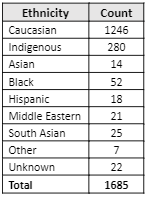Date: Wednesday, January 15, 2025
Victoria, B.C. – Following our response to an order from the Human Rights Commissioner of B.C., VicPD is sharing Use of Force data with our communities.
In November 2024, VicPD received an order to share Use of Force data from 2018 to 2023 with the Office of the Human Rights Commissioner of B.C., with particular focus on race-based data associated with incidents where force was used. Last week, we provided the data and, in accordance with our principles of transparency, this data is also being shared with our communities.
What Is Use Of Force?
For the purposes of this report, use of force includes any soft physical control that causes injury to the person or the officer, any hard physical control, intermediate weapon display or discharge (e.g. baton, aerosols or conducted energy weapons), display or drawing of a firearm, discharge of a firearm, police dog bites, use of specialty munitions and/or use of weapons of opportunity.
The specific type of force used in each incident has not been identified. In accordance with the VicPD Use of Force training and policy, officers use crisis intervention and de-escalation techniques prior to and/or in conjunction with the application of force.
Use of force is usually reported in the format of subject behaviour, officer response (SBOR) and recorded as a report by each officer involved in an incident. See more information in An Important Note on Reporting, below.
Use Of Force Overview
In total, VicPD had an average of 280 use of force incidents each year. For reference, calls for service in each year range from 48,000 to 59,000, meaning that force is used in approximately 0.4 per cent to 0.5 per cent of all calls for service.

Race-Focused Data
A review of the race-focused data shows an over-representation of Indigenous persons related to the local population. This is reflective of the justice system overall, and the over-representation of Indigenous persons in other areas, such as the unhoused population, and does not indicate a choice to use force on one specific ethnicity over another.
VicPD officers receive specific training on racial bias, and ongoing opportunities to better understand the historic and current impacts of colonization on the Indigenous community, and to build positive relationships with our Indigenous partners. You can read VicPD’s policy on fair and impartial policing.
Additional information about causes of over-representation of Indigenous persons in the criminal justice system can be found on the Government of Canada website and Statistics Canada.


Youth-Focused Data
A total of 56 incidents over six years, or three per cent of all use of force incidents, involved youth. Of those, 25 per cent involved non-Caucasian youth, which is in-line with the overall use of force data.

*Does not include three incidents where ethnic identity is listed as Unknown
How Is Ethnicity Identified?
Ethnic information is based on what the officer inputs into the database. This could come from self-disclosed data (e.g. the person tells the officer their ethnicity), officer perception, or legacy information. The exact source of this input is not specified and there may be some inaccuracies.
What’s Missing?
When we focus on data, we often miss important contextual information. For example, this report does not include information on whether the use of force was officer-initiated or subject-initiated, or the type of calls where force was used. It also does not identify the various levels of force and how often each was used.
Can We Reduce Use Of Force?
While we can always look for opportunities to resolve situations without use of force, it is simply a reality of policing. VicPD officers follow the National Use of Force Framework and Crisis Intervention and De-escalation Model. In most cases, officers choose to use the lowest level of force possible to resolve a situation. In many situations, the only way to reduce the use of force would be to cease apprehending an individual who has committed a crime, or to release any person who initiates a use of force against an officer.
An Important Note On Reporting
Use of Force data is regularly reported to B.C. Police Services. In that reporting, each officer’s use of force is counted. For example, if three officers respond to an event and each displays a conducted energy weapon (CEW), that would be three SBOR reports. For the purposes of the report to the Human Rights Commissioner of B.C., we were requested to provide total use of force incidents rather than SBOR reports. For example, whether one or four officers used force, it counts as one incident of use of force.
In 2022, VicPD revised our policy on reportable use of force to align with provincial standards, better defining the threshold for submitting a report. This change means that we were reporting more types of force, or over-reporting compared to other agencies, until 2022. The 2023 use of force data more accurately reflects reportable use of force incidents.
Find more information and data on use of force in B.C.
Reading The Data
The deidentified data in the spreadsheet is tabbed by year. There is a column identified as ‘Role’ which identifies whether the individual is:
2 – Charged
34 – Suspect Chargeable
39 – Recommend Charge
102 – Youth Charged
134 – Youth Suspect Chargeable
Use Of Force Raw Data 2018-2023
-30-
